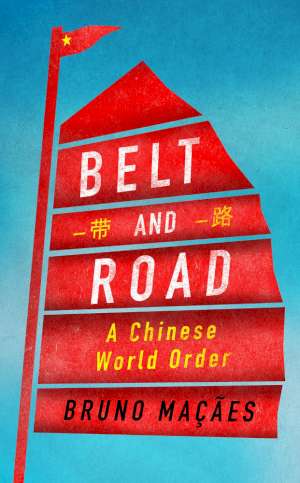25 March 2019
Belt and Road
A Chinese World Order
Bruno Macaes
2018, Hurst, 194 pages,
ISBN 9781787380028
Reviewer: Rosemary Connell

Belt and Road is the Chinese plan to build a new world order replacing the US-led one by slowly expanding Chinese power and influence across the world. It first entered government strategy documents in 2015, an ambitious initiative covering some 70 countries, land and sea. As well as being projects for economic and political expansion there are also military implications as evidenced by the building of dual ports for cargo and military vessels. It is envisaged as a global interdependent network of win-win projects.
By constructing infrastructure developments China has, among other things, facilitated its exports especially where it has over-capacity at home. Certain Belt and Road Continental corridors are designed to provide diversification for China’s energy needs lessening dependence on sources arriving via the Malacca straits.
The investments are based on repayable loans which are sometimes converted into equity stakes. This has led, in some instances, to countries being suspicious of Chinas motives and fearing that their sovereignty may be undermined.
China’s overseas lending clearly gives it economic and political leverage abroad and has in some instances helped the development of big data and artificial intelligence. For example a partnership with Zimbabwe has been signed (2018) for a facial recognition program for security, law enforcement and other uses. In 2017 Sri Lanka got its debt written down by handing control of a port to China possibly creating a naval outpost.
The author provides numerous examples of Chinese investments and influence together with details of the cooperation zones.
In the past China’s economic growth has been fast and relatively stable. This is now changing and China is now aiming to build efficient value chains that will enable it to occupy top market segments rather than rely on cheap labour. The author illustrates this with the example of China’s aim to lock up the supply of cobalt (essential for batteries) to enable it to control the electric car market.
International industrial capacity cooperation is one of China’s ways of providing some state guidance in a globalised world. To enter a global market one has to adopt the standards of that market or develop new ones of your own which will become widely accepted. China is exporting technical standards for high speed rail and when making investments aims to persuade countries to adopt Chinese standards for construction, finance or data handling.
The chapter on Belt and Road and World Politics gives details of dilemmas and pressures experienced by China/ India, relations with the rest of SE Asia and other parts of the world. Forest city, a novel concept, built from scratch is in Malaya (near Singapore) but many of its inhabitants are Chinese. Cities like this are expected to change the physical and human landscape, creating a new way of life. However, the Belt and Road progress is not expected to be smooth. For example, the Malay government has threatened to withhold visas from foreigners who want to live in Forest City. Countries are cancelling projects due to expense and China cannot provide all the finance. Slow penetration is the mantra for avoiding hostility as the tentacles of Belt and Road spread.
The author outlines four possible scenarios for China’s future place in the world and he also gives us a glimpse of a future world in 2049.
The book is an enormously insightful appraisal of China’s Belt and Road Project. It provides an extensive and very detailed panorama of events and plans. However, the outcome is unpredictable and uncertain in our changing world.
